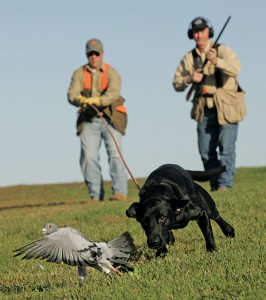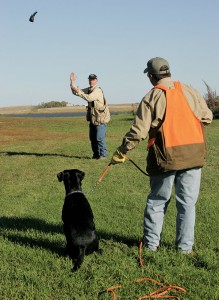June 27, 2013
By Tom Dokken
 There are many aspects of bird-dog training that will offer you a second chance should the first round not go as planned, but introducing your pup to gunfire isn't one of them. One misstep, and your dog may be ruined for life.
There are many aspects of bird-dog training that will offer you a second chance should the first round not go as planned, but introducing your pup to gunfire isn't one of them. One misstep, and your dog may be ruined for life.
Some folks opt to take their pups to the firing range, or fire a few rounds in the general vicinity of the dog just to see how it will react. Others employ the method of shooting blanks near a dog while eating in the hopes he will tolerate the sound and continue munching away. All of these options can work, but they can just as easily fail.
As a trainer, I have to use the safest route possible and leave nothing to chance. This is why it takes two full weeks to complete this make-or-break stage of development. It's a process, and an investment into every single future day afield.
Natural Instinct
Advertisement
My very first step to gunfire introduction involves finding something that a particular dog really loves to do. With retrieving breeds, this is often their natural inclination to go out and pick things up. We initially use frozen pigeons because there isn't anything quite like the real deal to fire up and engage a dog's interest.
We typically start with dogs around 5 months old, using a check cord and making short, fun retrieves with the pigeons. These sessions feature very little structure and are meant to be extremely enjoyable. As soon as the puppy is wild about chasing and retrieving the birds, we move on to the actual gunfire introduction.
Claps and Blanks
Advertisement
The first day of gunfire intro doesn't start with the gun. Instead, we opt for noise recognition. I'll stand 20 yards in front of the puppy where he can clearly see me, while my helper has the pup checked. I simultaneously clap my hands and throw the pigeon while my assistant releases the pup. We repeat this step so the puppy understands something good is going to happen every time I clap. It's important to make sure every time you do this, everything occurs in front of the puppy and you stop well before the dog loses interest.
It usually only takes a few sessions before the puppy will have its full attention glued to the thrower. This is the perfect time to introduce a .22 pistol loaded with blanks because the dog is anticipating some sort of noise, which in-turn signals it's time to do something fun. In an effort to keep the noise as subtle as possible, I load the pistol with blanks that feature acorn crimps for a very light report.
If this step goes well, I'll back up to 40 yards and shoot the pistol while tossing the pigeon. Ideally, the pup will charge out and retrieve the bird back to the handler. It's important the thrower continually watches the dog's body language. Look for any hint of insecurity or uncertainty. This could be as simple as a little blink when the gun goes off, a dropping of the ears, or a tiny flinch. If I notice any of these things, the session stops and I'll start over at 20 yards with hand claps. If everything is going well, the dog will complete four retrieves per session.
Slow Success
In the next step, start at 40 yards with the pistol and move five yards closer as your dog experiences a few successful retrieves. Always pay attention to the dog's body language. If he shows any signs of insecurity, immediately back out farther.
Eventually, I'll work in to as close as 20 yards, always through five-yard increments. After the pup has proven he can handle that, I'll work my way to 10 yards. This is accomplished through double sessions each day, with an emphasis on patience. It's easy to get overzealous and move in too close, or force too many retrieves per session, but you need to be cognizant of how slowly this should progress.
If the pup is still birdy after the 10-yard retrieve, aggressive, and showing no signs of uncertainty, start the following session at 15 yards; then move to 10 and five. At this point, we still have not shot a single time behind the dog, instead opting to always shoot (or clap) where he can clearly see the source of the noise.
Shoot, Retrieve, Repeat
When your pup is ready, it's time to stand directly next to him, throw the pigeon and shoot. This is prep work for the next stage, which involves letting the puppy run out and then shooting as he is retrieving. That is the first time I'll shoot behind the puppy, and I'm always watching for any hesitation.
If you can get through a few sessions without any worries, it's time to start the entire process over, except use a .410 shotgun instead of the .22. This should only take a few days, and then repeat the training with a 20-gauge, and again with a 12-gauge. This may seem like overkill, but remember the whole process takes about two weeks, and will be well worth it.
 If all goes according to plan, I introduce a new element to the training by using a pigeon wing attached to a fishing rod. I simply want the pup to chase the wing around for a bit before I let him catch it. Then it's on to using clipped-wing pigeons. As with starting anything new, it's important to keep it as fun as possible.
If all goes according to plan, I introduce a new element to the training by using a pigeon wing attached to a fishing rod. I simply want the pup to chase the wing around for a bit before I let him catch it. Then it's on to using clipped-wing pigeons. As with starting anything new, it's important to keep it as fun as possible.
Once the dog is comfortable with this, I start the whole process over with the clipped-wing pigeons, working my way through the various distances and firearms (ending with the 12-gauge). The dog should be extremely excited about the training sessions at this point and you should be able to take a live pigeon, dizzy it up, place it in the grass and let the dog flush the bird. Once flushed, shoot the pigeon and encourage the pup to retrieve it. This teaches the bird will be shot in the air and come down for them to retrieve.
You can screw up teaching your dog to sit, or heel, and eventually right that wrong. Introducing them to gunfire is different because you may only get one chance. Don't turn your potential hard-charging bird dog into a house pet by forcing gunfire on him in a haphazard manner. Take the time, follow these crucial steps, and reap the eventual rewards.
